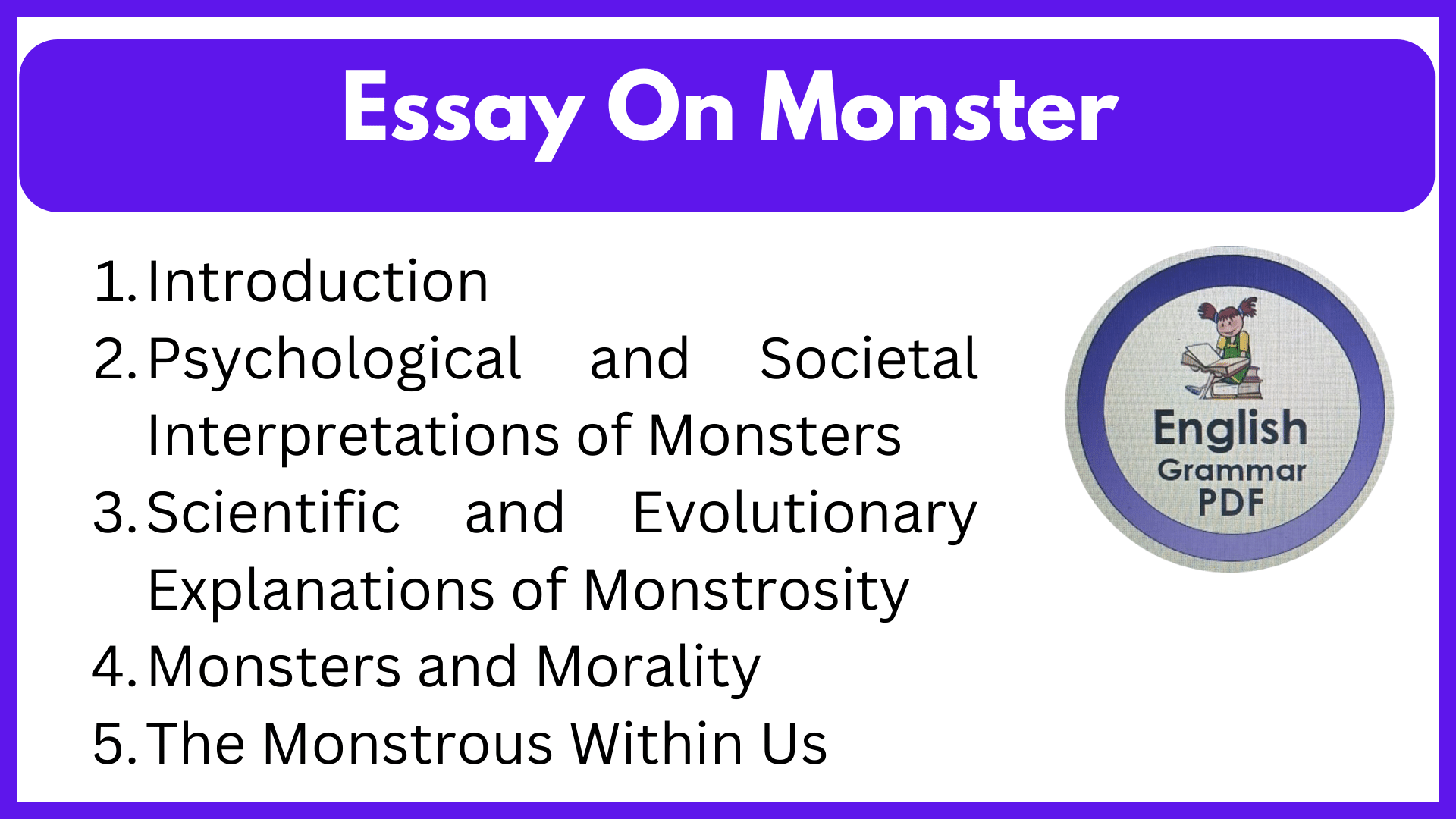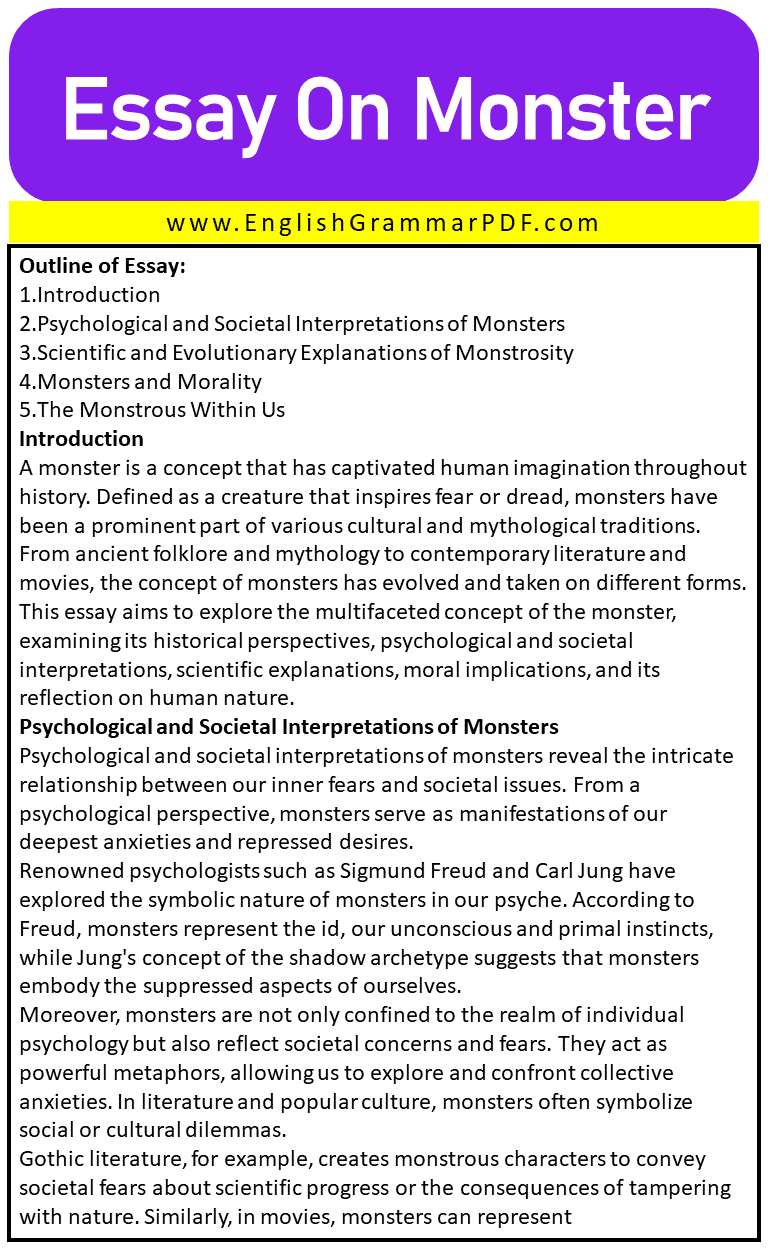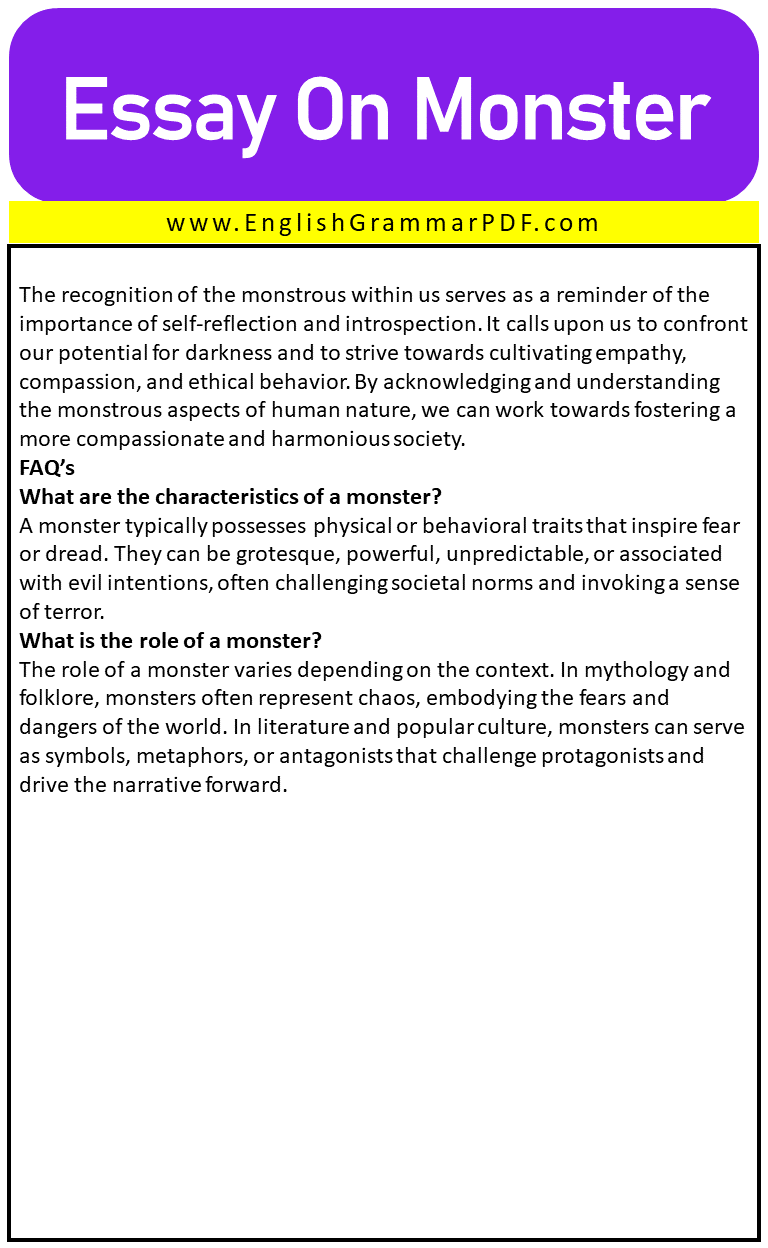Essay On Monster
Outline of Essay:
- Introduction
- Psychological and Societal Interpretations of Monsters
- Scientific and Evolutionary Explanations of Monstrosity
- Monsters and Morality
- The Monstrous Within Us
Introduction
A monster is a concept that has captivated human imagination throughout history. Defined as a creature that inspires fear or dread, monsters have been a prominent part of various cultural and mythological traditions. From ancient folklore and mythology to contemporary literature and movies, the concept of monsters has evolved and taken on different forms. This essay aims to explore the multifaceted concept of the monster, examining its historical perspectives, psychological and societal interpretations, scientific explanations, moral implications, and its reflection on human nature.
Psychological and Societal Interpretations of Monsters
Psychological and societal interpretations of monsters reveal the intricate relationship between our inner fears and societal issues. From a psychological perspective, monsters serve as manifestations of our deepest anxieties and repressed desires.
Renowned psychologists such as Sigmund Freud and Carl Jung have explored the symbolic nature of monsters in our psyche. According to Freud, monsters represent the id, our unconscious and primal instincts, while Jung’s concept of the shadow archetype suggests that monsters embody the suppressed aspects of ourselves.
Moreover, monsters are not only confined to the realm of individual psychology but also reflect societal concerns and fears. They act as powerful metaphors, allowing us to explore and confront collective anxieties. In literature and popular culture, monsters often symbolize social or cultural dilemmas.
Gothic literature, for example, creates monstrous characters to convey societal fears about scientific progress or the consequences of tampering with nature. Similarly, in movies, monsters can represent real-world problems like nuclear warfare or environmental destruction.
Scientific and Evolutionary Explanations of Monstrosity
Scientific and evolutionary perspectives offer intriguing explanations for the concept of monstrosity. From genetic abnormalities to adaptive advantages, these explanations shed light on the origins and existence of monstrous traits.
In scientific terms, monstrosity can be attributed to genetic abnormalities and physical deformities. Certain medical conditions can lead to individuals having appearances that are considered monstrous by societal standards.
Conditions like hypertrichosis, which causes excessive hair growth, or Proteus syndrome, characterized by abnormal tissue overgrowth, can contribute to a person being perceived as a monster. Understanding the underlying genetic and physiological factors behind these conditions helps explain the physical manifestations of monstrosity.
From an evolutionary standpoint, the survival and existence of monstrous creatures can be explained by adaptive advantages. Some monstrous traits may provide benefits for survival and reproduction in specific environments.
For example, the anglerfish, with its terrifying appearance and bioluminescent lure, have evolved to thrive in the deep sea. Its monstrous appearance helps it attract prey and navigate in the dark depths effectively. This adaptation illustrates how certain monstrous traits can confer advantages in their natural habitats.
Monsters and Morality
Monsters and morality have a longstanding relationship, intertwined in various cultural and literary narratives. Throughout history, monsters have often been depicted as metaphors for evil and immorality. In religious texts and moral teachings, monstrous creatures, such as demons or mythical beasts, symbolize the embodiment of wickedness and serve as cautionary figures.
These representations aim to reinforce moral values and guide individuals toward virtuous behavior. They emphasize the struggle between good and evil, highlighting the importance of making morally righteous choices in the face of temptation or adversity. By personifying evil in monstrous forms, moral teachings seek to establish a clear distinction between right and wrong.
However, the portrayal of monsters is not always straightforward. Some narratives challenge the traditional binary between good and evil by presenting monsters in a sympathetic light. This moral ambiguity invites audiences to question their preconceived notions and explore the complexity of morality.
Characters like Frankenstein’s creature or the misunderstood vampire Count Dracula evoke empathy, forcing us to confront the blurred boundaries between good and evil, and the potential for compassion even within monstrous beings.
Moreover, monsters can serve as representations of societal outcasts, marginalized individuals who are seen as different or threatening. By examining how monsters are treated and perceived in society, these narratives shed light on issues of discrimination, prejudice, and the consequences of social exclusion.
The Monstrous Within Us
The concept of the monstrous within us delves into the depths of human nature, exploring the potential for darkness and evil that resides within each individual. It raises unsettling questions about the capacity for monstrosity that exists within the human psyche. Throughout history, examples of human monstrosity have emerged, reminding us of the terrifying potential that lies within us.
The dark side of human psychology reveals a spectrum of traits that can lead to monstrous behavior. The capacity for violence, cruelty, and indifference towards others can manifest in individuals, causing immense harm and suffering. From notorious serial killers to tyrannical dictators, the annals of history bear witness to the chilling depths of human depravity.
Literature and philosophy have often grappled with the fear of becoming a monster. The “Jekyll and Hyde” complex, as depicted in Robert Louis Stevenson’s famous novel, explores the internal struggle between our virtuous selves and the sinister desires that lurk within. It reflects the constant battle between good and evil, highlighting the precarious balance that defines human morality.
The recognition of the monstrous within us serves as a reminder of the importance of self-reflection and introspection. It calls upon us to confront our potential for darkness and to strive towards cultivating empathy, compassion, and ethical behavior. By acknowledging and understanding the monstrous aspects of human nature, we can work towards fostering a more compassionate and harmonious society.
FAQ’s
What are the characteristics of a monster?
A monster typically possesses physical or behavioral traits that inspire fear or dread. They can be grotesque, powerful, unpredictable, or associated with evil intentions, often challenging societal norms and invoking a sense of terror.
What is the role of a monster?
The role of a monster varies depending on the context. In mythology and folklore, monsters often represent chaos, embodying the fears and dangers of the world. In literature and popular culture, monsters can serve as symbols, metaphors, or antagonists that challenge protagonists and drive the narrative forward.
Explore More Essays:
Download the PDF of the Essay:







